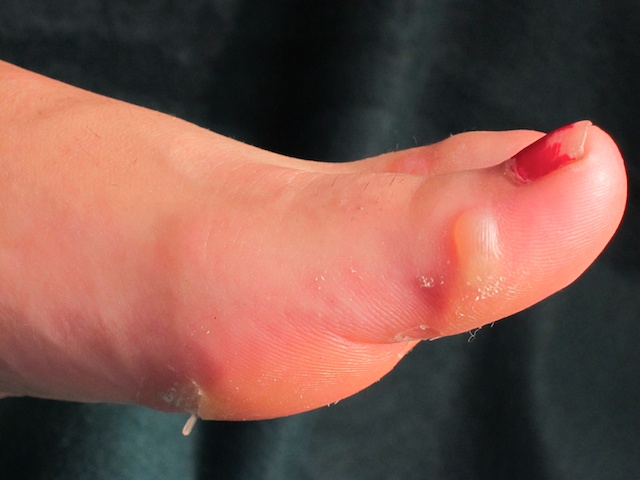 New Health Guide
New Health Guide
The agonizing and uncomfortable pain blisters on toes usually appear on the upper layers of the skin which is called the epidermis. The colorless liquid inside the blister, known better as a serum or plasma, bubbles up below the tiers of the epidermis. The red blisters on toes indicate the blister is gorged with blood. Normally, yellow or greenish blisters on toes, indicate the presence of an infection due to the pus deposited in the blister.
Painful blisters on toes form when resistance caused from swelling or sweaty feet meet the skin with repetitive chafing. Simply by picking up the pace while walking and wearing improper footwear aggravates and exasperates a blister. Bunions, hammertoes and other irregular characteristics of the feet often lead to uncomfortable blisters.
Wearing ill-fitting shoes affect and bring about blisters on toes. Instigating the problem repeatedly, over time, produces thick layers of hardened skin on your feet. The irritated blisters meeting resistance with ill-fitting shoes lends an ideal environment for blisters on toes to grow.
Wearing wet socks and shoes for a couple of hours ripen the environment on your feet perfectly for a fungus to mature, progressing into Athlete’s Foot. The symptoms include irritating, burning, and itchy sensations marked by red blisters on toes and the rest of the foot. Fungal infections are treatable with anti-fungal medicine, and usually diminish quickly with proper care.
Blisters on toes develop easily if we are allergic to the ingredients woven into materials that make up our socks. Irritation and chafing becomes an issue then the blisters materialize. Small punctures like bees and spiders give us by stinging and pricking us triggers an allergic reaction leading to blisters on toes.
 Blisters, harmless afflictions, are fluid retained pockets underneath the top layers of skin. Although they are harmless, blisters on toes irritate, distress, and cause anxiety. Often, people’s lives become unbalanced thanks to the inability to focus on daily tasks attributable to the itchy, irritating blister on toes.
Blisters, harmless afflictions, are fluid retained pockets underneath the top layers of skin. Although they are harmless, blisters on toes irritate, distress, and cause anxiety. Often, people’s lives become unbalanced thanks to the inability to focus on daily tasks attributable to the itchy, irritating blister on toes.
Almost all blisters disappear once your body absorbs the liquid from the pocket of raised skin and the old skin dries up and falls off. Beneath the blister, new skin grows, and your body cycles out the old, naturally without any need of external medical care.
Wrap some ice cubes in cloth and apply it to the blisters would help to ease the discomfort as well as speeding up the recovery to even just a few hours. In severe case, it may take a day or two for the blisters to go away.
Safely drain a blister that is painful and large:
Warnings: Some raised skin conditions actually are contagious diseases. If you have diabetes, HIV, cancer, heart disease or possible chicken pox, do not attempt to drain. Seek medical advice at once.
Use an antibacterial ointment at the earliest onset of a blister to prevent painful infections. Apply the antibacterial ointment at least daily until the blister disappears. Some brands of ointment also contain a pain alleviator, which is a helpful ingredient for blisters on toes.
Before you go to bed, try to soak your feet in one quart of warm water. The warm water alleviates or tones down the blisters, aiding the blister in withering away.
Pads cushion the blisters prevalent on the bottom of your feet. Purchased from a drug store, the pads aid in comfort and do not irritate the blisters on toes and the bottom of your feet. Cut them to the size of your blister. Remove the pads at night to allow your blisters to breathe.
While sitting at home, physicians agree, that is the best time to remove the bandage covering the blister and expose it to air. This type of exposure aids in the blister drying out safely and cleanly.
When making your bandage for the blister on your toe, raise the sides of the bandage causing the center-padded area of the bandage in the middle to rise up as well, secure the sticky part to the skin. Using this method, forces air into the wound, helping it to heal faster. Locate the types of bandages with the antiseptic medicine already inserted into the bandage; ask your doctor or pharmacist to show you how to make one.
Tips: Until the blister disappears, keep it covered, clean, and free from moisture with a bandage. During the healing phase, refrain from scratching or irritating the blister further. You can prevent the blister bothering you if it feels itchy by applying a cold wet compress to the area. Soak a clean towel in a basin of ice water, and apply to the affected area when necessary. Most important is to keep the blister clean and free from applied pressure while it heals.
For more information about foot blisters such as their causes and treatments, watch the video below: